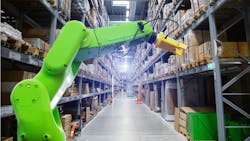Next-Gen Warehouses: Advanced Automation Takes Center Stage
It’s no secret that warehouse inventory management is in dire need of change. Inefficiencies have grown increasingly glaring as supply chain disruptions abound and productivity demands rise. This heightened awareness has spurred a technological shift in the industry.
Automated warehouse solutions have garnered much attention amid this trend. As more facilities embrace them, industry-wide standards will rise. Before long, more than simply automating a few processes will be necessary. Warehouse managers must consider broader, more advanced automation initiatives in response.
The Current State of Warehouse Inventory Management
Right now, warehouse inventory management remains largely unautomated. As recently as 2021, more than 80% of warehouses used no automation whatsoever. A growing number have switched to digital inventory management tools, but manual processes still prevail.
While automation is far from an industry standard today, that won’t be the case for long. Despite these low adoption figures, the sector is on the verge of rapid tech-driven transformation. According to a 2023 report, over 75% of companies plan to automate at least some warehouse operations by 2027.
Keep in mind that these predictions reflect organization’s feelings with today’s level of technology. Within a few years, the warehouse automation market will have more options to choose from, including more affordable and higher-functioning solutions. As that happens, investment in these innovations will rise.
These early signals suggest automation will reshape the warehouse industry before long. Businesses that hope to make the most of that shift and remain competitive amid rising tech adoption should pay attention to how they use this technology. That means accounting for a few key implementation considerations.
Extending Physical Automation
The first and most foundational measure to take is to automate physical warehouse tasks. Strenuous, repetitive physical jobs like picking and material handling typically have the most to gain from automation, as they’re unsafe and inefficient when done manually. This makes them an ideal first step in warehouse automation.
Conveyor systems and similar inflexible material-moving solutions are physical warehouse automation at its most basic. While beneficial, these applications don’t deliver substantial enough improvements or have enough adaptability to be reliable fixes.
Automated guided vehicles and similar mobile robots are more expensive but have more long-term potential. AI functionality like machine vision allows these systems to adapt to inconsistent load sizes, weights and orientations. Some can determine the ideal way to load trucks or shelves in less than 500 milliseconds—a figure that will only improve with time.
Automating Digital Tasks
Of course, physical processes are just part of warehouse inventory management. Advanced automation initiatives must also consider digital tasks. While digital processes are more efficient than pen-and-paper alternatives, they still have room to improve when warehouses manually manage them.
A warehouse management system is the first step. Some companies have seen 70% increases in inventory accuracy after implementing these centralized, cloud-based solutions. Using one with automated features like real-time alerts and automatic restocking orders will make them even easier to use and reduce errors.
Non-inventory-related tasks can also benefit from software automation. Billing, freight factoring, and similar administrative workflows are time-consuming and error-prone, making them optimal automation candidates. Efficiency and cost savings in these areas will sustain long-term growth if warehouses’ physical automation benefits plateau.
Ensuring Flexibility Amid Rising Automation
Organizations must ensure flexibility as they bring warehouse automation solutions to more processes. One of automation’s most prominent obstacles is that it often doesn’t adapt to changing circumstances as well as humans. Warehouse managers must address this challenge to get more out of their automated systems.
Investing in AI and the Internet of Things (IoT) is an important step. IoT connectivity provides real-time data to alert automation solutions of developing changes, which they can interpret to adjust their operation accordingly. Warehouses must also form workflows around robots and human workers to ensure the former can benefit from the latter’s flexibility.
Optimizing conditions around automated workflows can boost adaptability, too. Using wire decking instead of solid shelving, for example, provides more inventory visibility and increases storage capacity for easier inventory changeovers. As minuscule as these steps may seem, they let workflows be more flexible when unexpected issues arise, leading to compounding benefits.
Equipping the Workforce for Advanced Automation
Relatedly, warehouses must consider how rising automation will impact their workforce. More precisely, they should ensure their automation initiatives complement workers instead of replacing them.
Using collaborative robots—which work alongside humans by design—is a good first step. However, warehouse managers can’t stop there. Upskilling is also crucial, as more advanced automation solutions will require new skills and knowledge to work with effectively.
A lack of skills and experience is already a leading barrier to automation, with 55% of surveyed organizations citing it as a top challenge. Warehouses can close this gap by training their current staff in programming, AI solutions and managerial tasks involving tweaking workflows to achieve maximum productivity.
Refining Automation Initiatives
Companies must benchmark and monitor the performance of their warehouse automation solutions. It’s impossible to capitalize on any investment fully if leaders can’t quantify the results. Carefully watching and optimizing automation is important given these systems’ high upfront expenses.
This optimization starts with setting benchmarks for inventory visibility, warehouse efficiency and ongoing costs before automating. Warehouse managers should continue to measure the same KPIs after automating anything or adjusting an existing automated system. It’s similarly important to record any unexpected challenges to aid smoother tech adoption in the future.
Automation optimization should address more than just normal warehouse metrics. Warehouses also need to pay attention to increased automation’s unique risks, namely cybersecurity. Supply chain cyberattacks impacted more than 2,700 entities in 2023 alone, so warehouses must refine their security measures as they embrace new technologies.
Warehouse Automation Solutions Drive the Future of Logistics
Warehouse inventory management is changing. Manual methods are falling out of favor, even though they’re still the most common strategy today. As more businesses automate these processes, leaders will have to look beyond simple automation to stay at the forefront of technology.
The logistics industry is nearing a new phase in Industry 4.0. Automation initiatives must ramp up alongside broader industry adoption to sustain this technology’s benefits into the future.
About the Author

Emily Newton
Emily Newton has eight years of creating logistics and supply chain articles under her belt. She loves helping people stay informed about industry trends. Her work in Supply Chain Connect, Global Trade Magazine and Parcel, showcases her ability to identify newsworthy stories. When Emily isn't writing, she enjoys building lego sets with her husband.






